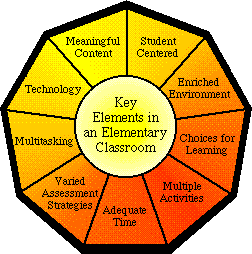
~ Water, Water Everywhere ~
Internet Integrated Thematic Unit
About this project: My research began with finding sites in order to create "Water, Water Everywhere" - an Internet integrated thematic unit. Before going into the unit, however, I thought a brief introduction to the concept of integrated curriculum might be useful.

What is Integrated Curriculum and Why Should I Use It?
The brain works by recognizing patterns and connections. An integrated curriculum allows educators to facilitate this "connection-building" in our students. Integrated curriculum also allows students to see the relevance of the learning to their own lives. Students see the connections of their learning to other curriculum areas as well as to "the real world." Carla Mathison and Cheryl Mason from San Diego State University use this example:
In his literature class, Mr. Cline gives students the dates of the birth and death of a famous author, and asks them to
figure out how old the author was when she died. Silence falls over the class as students scratch their heads in frustration. One
student exclaims, "It's hard to do math in English class!"
In the traditional segmented curriculum, students often do not realize that they have the knowledge to solve new problems or understand new concepts. They have never been shown the connections between the various disciplines.
An integrated curriculum uses many key elements to make these connections apparent to students. Plano ISD presents them as:


Back to Top

How can I Create an Integrated Curriculum?
There are many steps to building a unit of study.
- The first step is to identify the content standards and goals for the students.
- The next step in creating an Internet integrated thematic unit is to choose a theme. The theme should be broad enough to encompass many curriculum areas. This theme may be a concrete topic such as "water," an abstract concept like "explorations," or a guiding question, such as "What makes it tick?" Plano I.S.D. has chosen a group of overarching concepts to guide their entire year. Within this "big idea," you will have "essential questions" and "sub-essential questions" to further guide and focus the learning.
- Next, the performance assessment(s) need to be determined. How will you know when your students have met the required objectives?
- NOW you can begin to put together activities, using multiple intelligences, Bloom's taxonomy, and other concerns. The Utah State Office of Education offers a worksheet to help teachers plan their activities.

Back to Top

What Might an Integrated Curriculum Look Like?
Heidi Hayes Jacobs, in Interdisciplinary Curriculum (ASCD, 1989), defines ten views for integrating the curricula:
- Fragmented - the traditional model of separate and distinct disciplines, fragmenting the subject areas
- Connected - within each subject area, course content is connected
- Nested - within each subject area, the teacher targets multiple skills: a social skill, a thinking skill, and a content-specific skill
- Sequenced - topics or units of study are rearranged and sequenced to coincide with one another, while remaining in separate subjects
- Shared - two disciplines overlap concepts or ideas
- Webbed - an overall theme is webbed to various disciplines
- Threaded - thinking skills, social skills, multiple intellligences, technology and study skill are threaded through the various disciplines
- Integrated - subjects are overlapped in topics and concepts, with some team teaching
- Immersed - the learner filters all content through their specific area of intense interest (e.g. graduate students, doctoral candidates, etc.)
- Networked - the learner makes internal connections of learning, which lead to extentions into various disciplines
Click here to see a visual representation of these models.

Back to Top

Some Examples of Internet Integrated Thematic Units
An Internet Integrated Thematic Unit - Traditional Literature - I put together this small example of how various disciplines can be webbed with the story of Cinderella for a class in the summer of 1997.
Water, Water Everywhere - A look at some of the many Internet resources available online to create an Internet Integrated Thematic Unit on water.
Water, Water Everywhere - Curriculum - Activities and ideas for a water unit, divided by disciplines.

Back to Top

Page maintained by Fran Dendy
Last updated: December 11, 1997
The views and opinions expressed on this page are strictly those of the page author.


 Water, Water Everywhere - A look at some of the many Internet resources available online to create an Internet Integrated Thematic Unit on water.
Water, Water Everywhere - A look at some of the many Internet resources available online to create an Internet Integrated Thematic Unit on water. Water, Water Everywhere - Curriculum - Activities and ideas for a water unit, divided by disciplines.
Water, Water Everywhere - Curriculum - Activities and ideas for a water unit, divided by disciplines. What is Integrated Curriculum and Why Should I Use It?
What is Integrated Curriculum and Why Should I Use It? How can I Create an Integrated Curriculum?
How can I Create an Integrated Curriculum? What Might an Integrated Curriculum Look Like?
What Might an Integrated Curriculum Look Like? Some Examples of Internet Integrated Thematic Units
Some Examples of Internet Integrated Thematic Units








